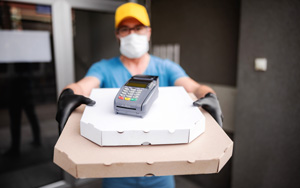 Nothing has felt normal in the past few months and things just continue to change as we move farther into the COVID-19 pandemic. States are starting to lift their stay-at-home orders and while it seems like business may return to usual, that is far from the reality.
Nothing has felt normal in the past few months and things just continue to change as we move farther into the COVID-19 pandemic. States are starting to lift their stay-at-home orders and while it seems like business may return to usual, that is far from the reality.
Retailers are going to be up against a list of sales, marketing, and cleaning tactics in order to stand out against the competition and keep the virus from spreading in their brick-and-mortar storefront. With all these changes coming into play, we’ve talked to the experts for you and here is the breakdown of what retailers should be working on.
Online Sales
Stay-at-home orders didn’t stop consumers from making purchases. According to ACI Worldwide Research, global ecommerce sales were up 209 percent in April, compared to the same period last year. To deal with all the state closures, brick-and-mortar retailers had to quickly figure out a way to make their entire business online-only and offer curbside pickup if they didn’t already.
“The businesses that are thriving during this pandemic are the ones who already set up reliable ecommerce strategies, shipping strategies, and weren’t very heavy on in-store locations,” John Lincoln, CEO of Ignite Visibility, said. “Those who are also doing well are integrated with third party selling platforms like Amazon, Walmart, and Google Shopping.”
Popular Products
The COVID-19 pandemic has not only changed the way consumers shop, but also what they are shopping for. Data has shown that sales in apparel and footwear have gone down, while health, wellness and fitness product sales have gone up. Consumers’ priorities have shifted with the stay-at-home orders, and now they’re trying to fit their entire outside life into their home.
A recent CommerceHub survey on COVID-19 shopping and delivery trends revealed an uptick in overall transaction volumes in March for industries that provide consumers with a sense of control during the pandemic, help them fill free time, or fill a gap left by essential services that are otherwise closed. “Unsurprisingly, the home fitness and home learning industries saw the greatest increase at 210% respectively. As stay-at-home orders went into effect, we saw an increase for the industries that best serve consumers who are staying in their homes,” Jonathan Parramore, Data Scientist II at Avalara.
The success of businesses during the COVID-19 pandemic has relied heavily on these specific industries, because it all comes down to what customers need in order to stay entertained while in quarantine. Some businesses have even shifted to selling certain items such as handmade face masks or CBD products to appeal to shoppers.
Marketing Tactics
Once the stay-at-home bans were put in place by states all across the country, retailers immediately had to figure out a way to transition their brick-and-mortar business to entirely selling online. “It’s been a super fast learning curve for retailers, especially those who have relied on in-store for a long time, and they pretty much all had to jump into finding ways to have delivery systems, online advertising, ecommerce sites, and furlough employees,” Lincoln said.
Lincoln has created a COVID-19 Marketing Survival Guide, in which he sums that there are more people online now than ever in the history of the world, which has created a huge amount of traffic on all websites. Companies have also started to cut back on their advertising spend, which is making it less expensive to get more visitors.
“What we’re seeing is people are having great success with refreshing all of their advertising, content marketing, email marketing, and talking to customers to get an idea of what their pain points are, how they’ve changed, and what they want to see in a product or service now,” Lincoln said. “Retailers are creating new promotions, products and services that fit the current landscape. When they refresh their online marketing, businesses are seeing online sales really double.”
Lincoln advises that when changing your product marketing, it’s important to set up two different strategies: an advertising strategy for the local market, and another marketing for the national market. Retailers should focus on the state level since states have different regulations, and savvy retailers can take advertising to the country level.
Curbside Pick-Up is Here to Stay
The same CommerceHub survey also found that convenience plays an overwhelmingly large role in customer satisfaction, and now safety is something that consumers are taking seriously and what retailers need to consider. Fifty-nine percent of consumers said they are more likely to use curbside pickup following the COVID-19 crisis, signaling an adoption of social distancing that might become more prominent once the pandemic subsides. Providing more ways for contactless shopping gives physical stores the ability to provide what a customer needs quickly while reducing shipping costs and increasing brand loyalty.
What Will Change & What Will Stay?
Given the uncertainty of the COVID-19 pandemic, Parramore says it’s hard to say which products will stay popular and when there will be another shift in consumer interest. As restrictions lift, shoppers will no longer need to be entertained at home, and we may start seeing apparel and footwear sales rise due to consumers wanting to get out of the house.
“It is important to note that what consumers are looking for after stay-at-home orders could likely vary based on geographic region, length of the stay-at-home orders, and other external factors. The past several weeks have created unprecedented changes in how we all live, so it is very possible that we will see a residual impact on consumer habits in the wake of the pandemic,” Parramore said.